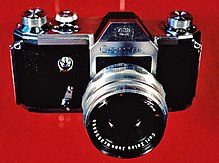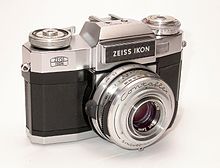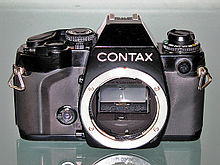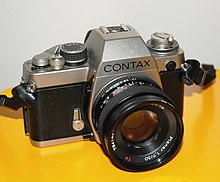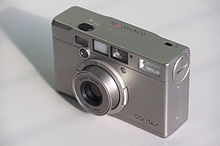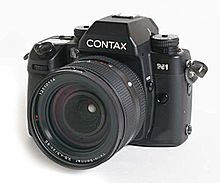Contax
Contax is a camera brand from Carl Zeiss . From 1932 to 2005 cameras from various manufacturers and designs were offered under this name, for which Carl Zeiss (and until 1958 also VEB Carl Zeiss Jena) supplied the lenses .
Contax cameras from Zeiss Ikon (Dresden)
In 1932, Zeiss Ikon AG launched its first 35mm camera , the Contax. The development was led by Heinz Küppenbender . The first Contax with its distinctive black case was initially only called the Contax. It was designed as a competitor to the Leica II , but already had a lens bayonet , a coupled rangefinder with a very large measuring base and a shutter made of metal blades. The newly developed Contax II followed in 1936 (the first rangefinder camera ever) and, in addition, the Contax III with an integrated light meter. The first Contax continued to be produced and was now called Contax I. Production ended in 1945 with the dismantling of Zeiss Ikon in Dresden. A camera production was to be set up in Kiev ; however, this was not possible due to improper dismantling and transport losses. In order to meet the reparation claims, the machines and tools at Carl Zeiss in Jena were rebuilt in a slightly reduced form in 1946 . Cameras created during tool testing in Saalfeld were sold in small numbers before the systems were transferred to Kiev in 1946, where production of the Kiev II and Kiev III began at today's Kiev Camera .
Contax cameras from VEB Zeiss Ikon (Dresden)
The construction of a Contax reflex camera had already started in 1938. At the Dresden location of Zeiss Ikon, the VEB Zeiss Ikon, expropriated in 1948, the Contax S was brought out in 1949 with a lens connection in the form of an M42 lens thread . It was the first single-lens reflex camera with a viewfinder prism that delivered a right-angle viewfinder image.
Jenő Dulovits patented the first single-lens reflex viewfinder for viewing at eye level with a laterally correct, upright image in Hungary on August 23, 1943 - with the Duflex (series production in 1948) he also designed the first 35 mm single-lens reflex camera for this viewfinder, which is common today - however, he did not use a roof prism, but individual mirrors.
From 1953, after the models only internally designated as A, B, and C, the technically significantly improved Contax D came on the market. It now bore the letter “D” on the case for the first time (the occasional claim that “D” stands for “roof prism” or “Dresden” is incorrect). From 1956 the Contax E with light meter and the Contax F and FB followed. Since the rights to the name Contax in the Federal Republic of Germany and in Western Europe were held by Carl Zeiss in Oberkochen, the name Pentacon was used for exports there . In the USA, the Dresden Contax cameras were sold under the names Astraflex, Consol, Hexacon and Ritacon. In 1958 the name Pentacon was generally used for the former Contax cameras.
Contax cameras from Zeiss Ikon (Stuttgart)
After the Zeiss Ikon AG headquarters were relocated to the company's Stuttgart location, the production of rangefinder cameras was set up there. The completely redesigned Contax IIa appeared in 1950 and the Contax IIIa in 1951 . These were significantly smaller than the pre-war models, and flash synchronization was also available. The cameras were discontinued in 1962 because Zeiss Ikon focused on single lens reflex cameras . These were given the names Contaflex , Contarex , Icarex and SL 706 and were built until 1972.
Contax cameras from Yashica / Kyocera
After Zeiss Ikon stopped manufacturing cameras in 1972, Carl Zeiss lacked a buyer for its 35mm lenses. Therefore they looked for a cooperation partner. After a collaboration with Pentax did not materialize, a cooperation agreement was signed with the Japanese camera manufacturer Yashica in 1972 . Yashica was acquired by Kyocera in 1983 . Kyocera took over the manufacture of the cameras. From 1974 to 2005, numerous cameras of different types were created as part of this cooperation.
The lenses were supplied by Carl Zeiss. In the first few years they were actually manufactured at Carl Zeiss in Oberkochen , but soon mainly Yashica (or Kyocera) and Tomioka were working as contract manufacturers. The terminology customary at Zeiss was used for the lens names. "Distagon" stands for wide-angle lens, "Planar" and "Tessar" for normal lenses, "Sonnar" for bright lenses and "Tele-Tessar" for long focal length lenses. Zoom lenses were always called “Vario-Sonnar” regardless of the focal length range.
In April 2005, Kyocera announced that it would stop selling Contax cameras during the year. This then happened in September 2005. A service for existing cameras should be maintained for up to ten years. The "Contax" brand is still owned by Carl Zeiss. However, it is still the subject of the cooperation agreement and therefore cannot be used by Carl Zeiss at the moment.
Contax RTS system
The first result of the cooperation which was published in 1974 small picture - SLR Contax RTS . "RTS" stands for "Real Time System" and is intended to symbolize the delay-free execution of the camera functions in real time through electronic control. Together with the “Professional Motor Drive” (PMD) offered as an accessory, a speed of five images per second was achieved. The design of the Contax RTS came from FA Porsche and was also modeled on the subsequent models. While the Contax RTS set out to be a professional camera, the Contax 139 Quartz from 1979 and the Contax 137 MD from 1980 were designed as more sophisticated amateur cameras. The Contax 137 MD was purely a timing machine, but it already had a built-in motor for film transport.
In 1982, the Contax RTS II appeared as the successor to the RTS . This had TTL flash control , measured value storage and a titanium lock . TTL flash also with RTS. Also in 1982 was the Contax 137 MA, a slightly improved successor to the 137 MD with additional shutter speed adjustment.
In 1984 the Contax 159MM with aperture and program automatic and the matching MM lenses were introduced. In 1986 the Contax 167MT appeared. It combined the extensive automatic functions of its predecessor with motorized film transport and the option of spot exposure metering. A rotary knob mounted around the release button also allowed permanent storage of the exposure value (as with 159MM). Furthermore, it was the first camera with the automatic exposure bracketing that is taken for granted today .
After all Contax models apart from the Contax 167MT had been discontinued, the system was not revived until 1990 with the Contax RTS III . Even more than its predecessors, it was tailored to professional requirements. Special features include the built-in data back wall for data exposure on the film bridge, the professional flash exposure meter and a ceramic film suction plate to achieve optimal film flatness.
1992 followed with the Contax ST, a somewhat simplified version of the Contax RTS III and with the Contax S2 manufactured by Cosina , a camera with a mechanically controlled shutter and exclusive spot metering . The almost identical Contax S2b followed in 1994 with center-weighted measurement.
The Contax RX also appeared in 1994 , a model with additional electronic focus detection , as is common with autofocus cameras , but still without automatic focusing. The Contax RX thus follows a construction principle that was briefly practiced in the 1980s with the Canon AL-1 and the Minolta X-600 as a preliminary stage of the autofocus cameras.
Such an autofocus camera for the Contax RTS system actually followed in 1996 with the Contax AX . In contrast to all other 35mm SLR cameras with autofocus, the Contax AX focuses by shifting the film plane instead of adjusting the lens. This means that all previous manual lenses on the Contax AX can be automatically focused. Due to the design, the housing of the AX is a little deeper, and the speed of the autofocus is slower compared to contemporary cameras.
As the successor to the Contax 167MT, the Contax Aria appeared in 1998, which offered a multi-field measurement for the first time , but had to forego the possibility of connecting a battery handle. Although the Contax-N system was presented in 2000, the Contax RXII was released in 2002, which in contrast to the Contax RX had to do without the electronic focus detector and was given a simpler lock; it was not offered in Europe or the USA.
Contax compact cameras (T models)
In 1984 the principle of the rangefinder camera was revived with the Contax T. This had the following special features:
- Carl Zeiss Sonnar 2.8 38 mm with five lenses in four groups
- Aperture with 7 blades
- Quartz-controlled closure with 5 blades
- Trigger as an artificial sapphire "Romande"
- detachable flash unit with guide number 14
- available in black and silver
The Contax T was otherwise based on the Minox 35 . It was initially set in 1987 without a successor.
Only in 1990 appeared as a successor mm film - compact camera Contax T2. It had a switchable autofocus and an integrated flash. Compared to the original T, it had a housing that was significantly modified and roughly corresponded to the competing models from Leica (minilux) and Nikon (35Ti). It was replaced in 2000 by the Contax T3 with a Carl Zeiss Sonnar 2.8 35 mm.
1993 appeared with the Contax T-VS a model with autofocus and zoom lens (VS = Vario-Sonnar) 3.5-5.6 28-56 mm, the 1998 with the Contax T-VS II with minor improvements and 2000 with the Contax T-VS III with a 3.7–6.7 30–60 mm zoom lens was replaced.
The Contax Tix with a 2.8 28 mm lens was released in 1998 as the only Contax camera for APS film .
Contax G system
→ see also main article: Contax G-System
In 1994 Kyocera went one step further and launched the Contax G1, an autofocus rangefinder camera with interchangeable lenses. The lens range comprised a total of six fixed focal lengths from 16 to 90 mm and later also a zoom lens 3.5–5.6 35–70 mm. In 1996 the successor model Contax G2 appeared with faster auto focus.
Contax 645
→ see also main article: Contax 645
In 1998 the first medium-format Contax, the Contax 645, was presented. It is a reflex camera for roll film format 4.5 × 6 cm. The Contax 645 has autofocus as well as changeable finders and magazines. Nine lenses, a teleconverter and numerous other accessories have been released for the Contax 645. The production has meanwhile been stopped.
Contax N system
→ see also main article: Contax-N-System
The Contax N1 was announced in 2000 as the first camera of the new Contax N system. This is a 35 mm mirror reflex camera with integrated autofocus and a new bayonet. The simplified Contax NX followed in 2002, as well as the only digital SLR camera under the name Contax, the Contax N Digital. It was the first digital camera with a full-frame sensor . The Contax-N system included an insufficiently developed range of nine lenses.
Contax digital compact cameras
In 2003, the Contax T VS Digital, the first digital compact camera under the name Contax, appeared. It largely corresponds to the Contax T VS III, but because of the small sensor it has a 2.8–4.8 7.3–21.9 mm lens and a CCD sensor with 5 megapixels (MP).
In the course of 2004, shortly before camera production was discontinued, Kyocera switched to offering digital cameras only under the name Contax in order to avoid price pressure. The Contax SL 300R T with 3.17 MP, which was developed from the Kyocera Finecam SL 300R, and the Contax U4R, which is largely identical to the Kyocera Finecam SL 400R, and the unusually designed Contax i4R with a fixed focal length lens 2.8 6.5 mm appeared below.
In April 2005, Kyocera announced that it would withdraw from the camera business. In September 2005, the delivery of Contax cameras and accessories was discontinued.
literature
- Hans-Jürgen Kuc: On the trail of the Contax. Volume I. Wittig Fachbuchverlag, Hückelhoven 1991, ISBN 3-88984-118-X , 272 pages.
- Hans-Jürgen Kuc: On the trail of the Contax. Volume II, 2nd edition. Wittig Fachbuchverlag, Hückelhoven 2003, ISBN 3-930359-34-0 , 266 pages.
Web links
- Official website of ToCAD America Inc. former Contax importer in the USA (English)
- Official website of Contax UK (English)
- German CONTAX contract service for repairs and original spare parts (German)
- Contaxinfo.com , Contax User Forum (German & English), MTF data lenses, scanned brochures and operating instructions etc.
Individual evidence
- ↑ Hans-Jürgen Kuč, In the footsteps of the Contax, page 25ff, Wittig Fachbuchverlag, 1992, ISBN 3-88984-118-X
- ↑ Dr. Heinz Küppenbender , Zeiss Historica
- ↑ Herbert Blumtritt, The History of Dresden photo industry, page 111, Verlag der H. Lindemann's bookstore, 2001, ISBN 3-89506-212-X
- ↑ Article at Photopedia (English)
- ^ Hummel: SLR cameras from Dresden
- ↑ Temporary end also for the German traditional brand Contax, which is manufactured under license - Kyocera withdraws from digital cameras , Handelsblatt
- ↑ Kyocera gives up camera business ( memento of the original from March 5, 2016 in the Internet Archive ) Info: The archive link was automatically inserted and not yet checked. Please check the original and archive link according to the instructions and then remove this notice. , photoscala


